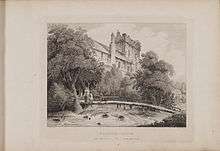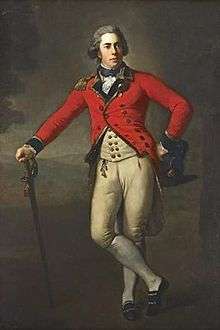Kensington Club

The Kensington Club is an exclusive all-male dining society composed of students of the University of St Andrews.[1]
Founded circa 1739 by Alexander the Laird Balgonie as a social club, the Kensington Club flourished predominately in the late eighteenth and early nineteenth centuries as a retreat for aristocratic and moneyed members of the student population.[2] Renewed interest in the club after a period of decline in the second part of the twentieth century has led to a surge in membership since the early 2000s.
History

The Kensington Club was founded circa 1739 by Alexander the Laird Balgonie.[3][4] His family seat, the Castle Balgonie, is still standing today close to St Andrews. The club was intended as a social club from its beginning, and was founded in the spirit of the many enlightenment societies which were springing up at the time. The exact origins of the club's name to this day remain unclear. A portrait of the club, now in the care of the Scottish National Portrait Gallery, depicts early members wearing a uniform of maroon frock-coats and turquoise-green silk waistcoats.[5]
Interest in the club reached its zenith in the early part of the nineteenth century despite the considerable amount of debt accumulated by its members in the pursuit of excessive lifestyles, as attested by a letter of the student Lord Ailsbury in 1847: “You must have heard of this club… There are many splendid dinners, receptions and infinite other amusements. There is much ritual and tradition from ancient sources but every day these are destroyed by the scandalous amounts of debt attributed to the members… the men of today, who count themselves as gentlemen, are very different in bearing and conduct from their ancient counterparts”.[6]
The policies of the labour governments in the early twentieth century were felt with particular acuteness among the Scottish aristocracy, with their limited ability to generate income. Club fortunes took a downturn and membership began to tail off. With the exception of a brief resurgence in the nineteen seventies the club remained almost dormant.[7] With the turn of the century interest began once more to escalate, and the Kensington Club once again exists as a prominent social institution within St Andrews.[8] In 2001, in honour of this revival, Raymond, the present Laird of Balgonie, was given honorary membership and made the club patron.
Reputation

Since its early days, the Kensington Club has had a reputation for excessive behaviour. When the Laird Stewart joined the club in 1773 he wrote of it to a friend in Aberdeen noting that “The treasure of these families is being put to such uses you would not believe.”[9]
The club's raucous traditions, rumoured to include a 'fox hunt' through town in which new inductees are chased by more senior members in full hunting regalia, have drawn speculation and criticism from university students and the public alike. In 2008 an investigation was launched after a club member managed to 'liberate' a rare and antique grandfather clock from inside a university hall of residence. The clock was subsequently returned. In 2012, members drew criticism for their involvement in the ‘champagning’ incident, in which students poured bottles of champagne over their heads in a video satirising the ‘milking’ craze of the time.[10]
Despite the club's at times boisterous nature, it maintains a relatively low profile at the University and beyond.
Relationship with the University
The Kensington Club is not affiliated with the University of St Andrews, or with the St Andrews Students Association, though members are selected from among the body of students. Louise Richardson, principal of the university, in 2012 levelled criticism at the club as an outdated and obsolete institution, noting that members should be aware of the effect that public knowledge of student’s membership might have on their futures.
Notable Alumni

- John Hamilton-Gordon, 1st Marquess of Aberdeen and Temair (1847-1934) [11][12]
- John Campbell, 9th Duke of Argyll (1845-1914) - President of the Club 1866-7 [13][14]
- David Erskine, 11th Earl of Buchan (1742-1829)[15]
- Sir David Carnegie, 4th Baronet (1753-1805) - President of the Club 1774-5 [16]
- George Dempster of Dunnichen (1732-1818)[17]
- Thomas Bruce, 7th Earl of Elgin (1766-1841)[18]
- Christopher Leighton Smith (1859-1950) - President of the Club 1881-2 [19][20]
- James Bowman Lindsey (1799-1862)[21]
- Roderick Maxwell Bruce (1744-1812) - President of the Club 1763-5 [22]
- William M'Intosh (1838-1931)[23][24]
- Thomas Simson Pratt (1797-1879)[25]
- William Gordon Rutherford (1765-1818)[26][27]
- George Kennedy Young (1911-1990)[28][29]
See also
University of St Andrews
Dining Club
Gentleman's club
References
- ↑ Read, John (1977). Historic St Andrews and its University; Revisions and Additions by Jan Read. Henderson.
- ↑ The St Andrews Society of St Andrews (1983). Discovering Old St Andrews. St Andrews University Press.
- ↑ Burnett, Don (2002). St Andrews: Ancient City in the Twentieth Century. Kinloss: Librario. p. 72.
- ↑ "The Kensington Club". The St Andrews Historical Journal. St Andrews Historical Press. September 1993.
- ↑ Anon. (1740). The Kensington Club / Five men beneith cameo of st Andrews.
- ↑ Smart, Robert (2004). Biographical Regester of the University of St Andrews. University of St Andrews Press.
- ↑ Burnett, Don (2002). St Andrews: Ancient City in the Twentieth Century. Kinloss: Librario. p. 72.
- ↑ Willsher, Betty (2003). St Andrews: Societies Past and Present. Kinloss: Librario.
- ↑ Smart, Robert (2004). Biographical Regester of the University of St Andrews. University of St Andrews Press.
- ↑ "Posh students from William and Kate's university pour CHAMPAGNE over their heads in video mocking milking craze". http://www.dailymail.co.uk/news/article-2247106/Posh-students-Scotlands-university-pour-80-bottles-champagne-head-video-mocking-milking-craze.html. Daily Mail Online. External link in
|website=(help); - ↑ Smart, Robert (2004). Biographical Regester of the University of St Andrews. University of St Andrews Press.
- ↑ Elliot, E. B. (1967). Memoir of Lord Haddo: In his later years the fifth earl of Aberdeen. 2nd Edition rev. with additions. London: Seeley, Jackson and Halliday.
- ↑ Smart, Robert (2004). Biographical Regester of the University of St Andrews. University of St Andrews Press.
- ↑ Willcock, John (1987). A Scots Earl: the life and times of John Campbell, Duke of Argyll. Edinburgh: Elliot.
- ↑ Smart, Robert (2004). Biographical Regester of the University of St Andrews. University of St Andrews Press.
- ↑ Smart, Robert (2004). Biographical Regester of the University of St Andrews. University of St Andrews Press.
- ↑ Smart, Robert (2004). Biographical Regester of the University of St Andrews. University of St Andrews Press.
- ↑ Smart, Robert (2004). Biographical Regester of the University of St Andrews. University of St Andrews Press.
- ↑ The Alumnus Association of the University of St Andrews (1925). The Alumnus Chronicle. Missing or empty
|title=(help) - ↑ Charles, McAlastair (1974). "The Secrets of the Kensington Club". College Echos: St Andrews University Magazine. Cupar: Printed for the proprietor by A. Westwood & Son.
- ↑ Smart, Robert (2004). Biographical Regester of the University of St Andrews. University of St Andrews Press.
- ↑ Charles, McAlastair (1974). "The Secrets of the Kensington Club". College Echos: St Andrews University Magazine. Cupar: Printed for the proprietor by A. Westwood & Son.
- ↑ Smart, Robert (2004). Biographical Regester of the University of St Andrews. University of St Andrews Press.
- ↑ Gunther, A. E. (1977). The Life of William Carmichael M'Intosh, M.D., F.R.S., of St Andrews, 1838-1931. Edinburgh: Scottish Academic Press for the University of St Andrews.
- ↑ Smart, Robert (2004). Biographical Regester of the University of St Andrews. University of St Andrews Press.
- ↑ Smart, Robert (2004). Biographical Regester of the University of St Andrews. University of St Andrews Press.
- ↑ Crockett, S. R. (2009). The men of the moss hags: being a history of adventure taken from the papers of William Gordon of Earlstoun in Galloway and told over again by S. R. Crockett; with an introduction by Richard D. Jac. Glasgow: Kennedy & Boyd.
- ↑ Smart, Robert (2004). Biographical Regester of the University of St Andrews. University of St Andrews Press.
- ↑ The Alumnus Association of the University of St Andrews (1954). The Alumnus Chronicle. Missing or empty
|title=(help)